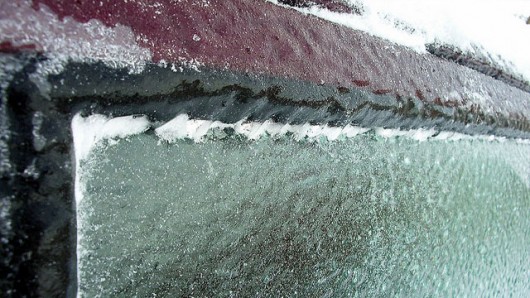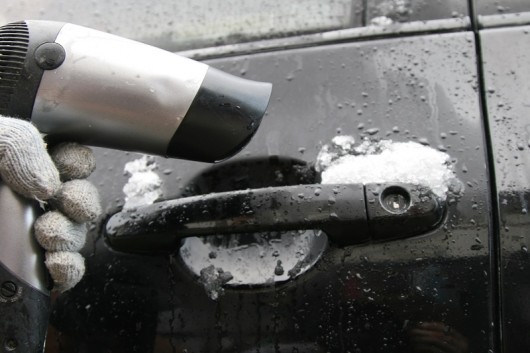How to prevent car doors from freezing
Ice is the main cause of huge problems for the car. For example, if your windshield is iced up, then you will not be able to drive a car, as this is very dangerous. But most often, ice causes problems for drivers, fettering the doors, handles and locks of the car, which creates, up to the inability to get inside the car. Fortunately, many of the problems associated with freezing and icing a car can be avoided. Here . Including you will learn what to do if, nevertheless, the car doors are frozen and you cannot get into the salon.
Inspect and clean rubber seals on car doors
Car doors in winter, as a rule, are frozen due to freezing of moisture, rain and melted snow or ice inside the passenger compartment and doors. Basically, water enters through old or worn rubber seals (cracks on rubber seals, various damages, abrasions, etc.) located on the body at the door contact points, which are installed just to prevent moisture from entering the car from streets.
Each driver should check the condition of the rubber door seals of the car. After all, you must agree that it is better to take measures in advance before bad rubber bands in the doors become a headache for you.
You should check and make sure that the door seals are not worn, torn or dirty. Remember that any damage or loose fit of the rubber bands will lead to the fact that moisture or water will get into the interior or even inside the doors, which will naturally turn into ice at low temperatures outside.
As a result, your doors and maybe even locks will freeze, and it will be very difficult for you to open the door or you will not be able to open it at all, as it will be ice-bound, like super glue.
If, during the inspection of the rubber bands of the doors, it turns out that they have told a lot in their lifetime, then they will have to be replaced with new ones.
If the rubber door seals are just dirty, then you need to do a quality cleaning. The fact is that dirt and various crumbs can cause the doors to lose sufficient sealing, which will allow water and moisture to enter the cabin.

In order to clean the rubber bands of the doors, you will need a clean rag and warm water. Your task is to clean not only the seals themselves, but all the frames on the body that are adjacent to the doors, as well as the rubber seals themselves installed on these frames. After wet cleaning the seals and frames of doorways, wipe them with a dry cloth or napkin to remove any remaining moisture.
When cleaning rubber seals, you must clean not only the rubber seals located on the body of the doorways, but also clean the rubber seals on the car doors themselves.
In winter, the rubber seals of car doors should be cleaned in a warm place (garage, underground parking, where the temperature is above zero in winter, or at a car wash in a closed box). That is, your seals are where it's warm. In this case, the water with which you will clean the seals from dirt will not freeze.
Protect car doors from freezing with lubricant
Of course, the best way to prevent freezing of car doors is to put it in a warm garage or warm underground parking. But, unfortunately, not everyone has the opportunity to put the car in a warm place in winter. Luckily, there are several ways you can protect your car from icing up the doors.
So the most popular tool that prevents freezing of car doors is silicone grease (spray).
Having bought silicone grease at any auto shop, you should spray it on the rubber door seals of the car and then evenly distribute it with a microfiber cloth over the entire surface of the door seals and rubber bands located on the body.
Remember that silicone repels water and will not allow moisture to get into the interior between the seals.
Silicone lubricant spray is quite cheap. High-quality lubricant costs an average of 110 rubles, which you can purchase at car dealerships, some hypermarkets or online stores.
If you cannot find silicone grease in stores, then many auto stores may sell other chemicals that are also designed to treat door seals and door locks.
How to open frozen car doors
When it comes to opening icy and frozen doors, it's best to anticipate freezing rain, freezing temperatures, and possible other precipitation that can turn your car into one piece of ice in a short time. After all, under such weather conditions (especially with freezing rain), even new rubber door seals will not save you from freezing doors. In any case, the door can freeze on the outside of the car and you will face a big problem to open it.
For example, in order to avoid the problem of icy doors after icing the car, you can place a thin rag or towel on the top frame of the door before leaving the car overnight in a street parking lot. Then just close the door and the rag will be between the top frame and the car body above the door. Thus, regardless of the weather conditions that contribute to the formation of ice, you can easily open the door.

But do not forget that regardless of whether you use a rag on the door in the evening, in the morning in case of severe freezing or icing of the car doors, you must clear the ice from the outside before opening the frozen door.
To do this, use a special manual scraper, which can be bought at any auto shop or grocery hypermarket.
Before opening an ice-covered door, you must remove the ice from the places where the door adjoins the car body (gaps between doors and body parts). If the thickness of the ice is too thick and you cannot clean the places where the doors fit on the body, then camphor spirit can help you), which you must dilute with water.
To do this, you need to take 2/3 alcohol and 1/3 water.
You can also buy a special liquid that will help you remove ice from car doors. As a rule, such products are also widely represented in automotive stores.

If you can’t open a frozen car door even with a hand scraper, special chemicals, etc., then it’s time to warm up the door with a hair dryer.











